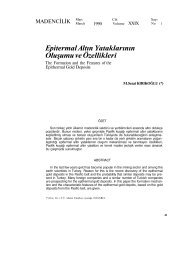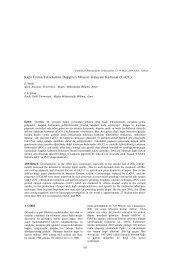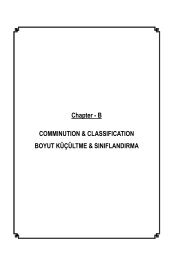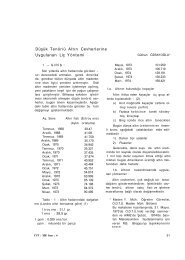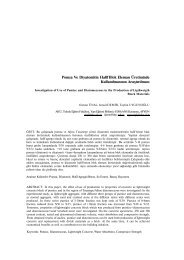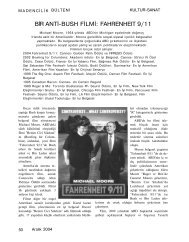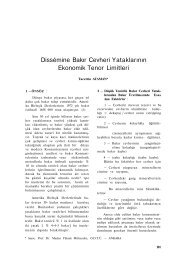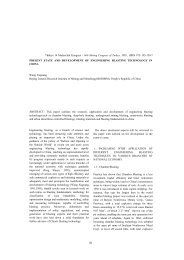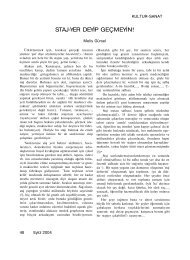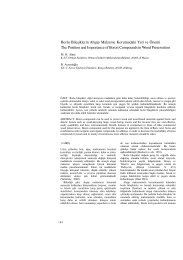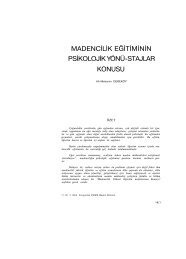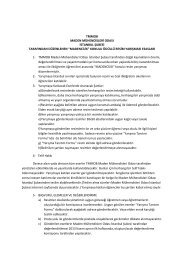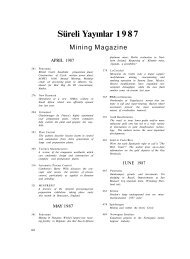A OPEN PIT MINING AÇIK OCAK MADENCİLİĞİ
A OPEN PIT MINING AÇIK OCAK MADENCİLİĞİ
A OPEN PIT MINING AÇIK OCAK MADENCİLİĞİ
You also want an ePaper? Increase the reach of your titles
YUMPU automatically turns print PDFs into web optimized ePapers that Google loves.
According to Storn and Price (1997,<br />
2002), there are three operations in DE<br />
including mutation, crossover, and selection.<br />
The general idea behind DE is a scheme for<br />
generating trial parameter vectors. Mutation<br />
and crossover are used to generate new<br />
vectors (trial vectors), and then selection<br />
determines which of the vectors will survive<br />
into the next generation.<br />
A. Mutation<br />
Mutation operation mutates a chromosome<br />
into a new one by inverting randomly<br />
selected genes of the chromosomes. For each<br />
target vector x<br />
i , G<br />
, a mutant vector v is<br />
generated according to equation 6.<br />
<br />
r1 r2 r3 i <br />
1,<br />
NP <br />
v x F x x<br />
i , G 1 r1, G 1 r 2, G 1 r 3, G 1<br />
<br />
(6)<br />
In which the indexes r1, r2, r 3 are chosen<br />
randomly. Note that these indexes are<br />
different from each other and from the<br />
running index i, therefore the number of the<br />
population must be at least four ( NP 4). F<br />
is a real number that controls the<br />
amplification of the difference vector<br />
x x .<br />
<br />
r 2, G 1 r 3, G 1<br />
<br />
B. Crossover<br />
Crossover operation crosses two or more<br />
chromosomes to create new chromosomes<br />
for the population. The target vector is mixed<br />
with the mutated vector, using the following<br />
scheme, to yield the trial vector<br />
<br />
ui , G 1 u1 i , G 1, u2 i , G 1 ,..., uDi , G 1<br />
(7)<br />
where<br />
<br />
<br />
<br />
v<br />
ji , G 1<br />
if r j CR or j rn i<br />
ui , G 1<br />
<br />
, j 1,...,<br />
D<br />
v<br />
ji , G<br />
if r j CR or j rn i<br />
r j 0,1<br />
is the j th evaluation of a uniform<br />
random generator number. CR is the<br />
crossover constant, which has to be<br />
determined by the user. rn j 1,...,<br />
D is a<br />
randomly chosen index which ensures that<br />
ui , G 1<br />
gets at least one element from v<br />
i , G 1<br />
.<br />
<br />
Otherwise, no new parent vector would be<br />
produced and the population would not alter.<br />
C. Selection<br />
Selection operation selects the best<br />
chromosome from the population for the next<br />
generation. In jDE a greedy selection scheme<br />
is used as well. In dealing with a<br />
minimization problem, the selection rule is<br />
as follow<br />
x<br />
i , G 1<br />
<br />
<br />
u if f u f x<br />
<br />
x<br />
i , G<br />
otherwise<br />
i , G 1 i , G 1 i , G<br />
for i 1,..., D . f is the objective or fitness<br />
function. If, and only if, the trial vector ui , G 1<br />
yields a better cost function value (minimum<br />
value in a minimization problem) than x<br />
i , G<br />
,<br />
then x<br />
i , G 1<br />
is set to ui , G 1; otherwise, the old<br />
value x<br />
i , G<br />
is retained.<br />
In jDE, the control parameters that will be<br />
adjusted by means of evolution are F and<br />
CR. Both of them are applied at the<br />
individual level. In means, the better values<br />
of these control parameters lead to better<br />
individuals, which, in turn, devise next<br />
generations with better parameter values. In<br />
each generation, new control parameters<br />
Fi , G 1<br />
and CRi , G 1<br />
are calculated as<br />
F<br />
i , G 1<br />
CR<br />
i , G 1<br />
F rand * F , if rand<br />
<br />
l 1 u<br />
2 1<br />
<br />
Fi , G<br />
, otherwise<br />
rand<br />
3,<br />
if rand<br />
4<br />
<br />
2<br />
(8)<br />
<br />
CR , otherwise<br />
i , G<br />
and they produce factors F and CR in a new<br />
parent vector. rand<br />
j<br />
, j 1,2,3,4<br />
, are uniform<br />
random values. <br />
1<br />
and <br />
2<br />
represent<br />
probabilities to adjust factors F and CR,<br />
respectively. According to Brest et al.<br />
(2006), if 1 <br />
2<br />
0.1, Fl<br />
0.1 and f<br />
u<br />
0.9 then<br />
the new F takes a value form [0.1,1.0] in a<br />
random manner. The new CR takes a value<br />
from [0,1]. Fi , G 1<br />
and CRi , G 1<br />
are calculated<br />
before the mutation process. Therefore, these<br />
new factors influence the mutation,<br />
crossover, and selection operations in<br />
124



